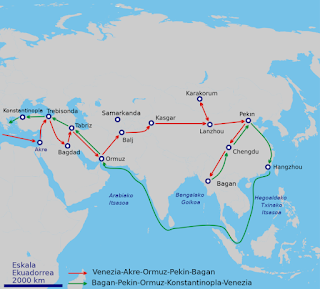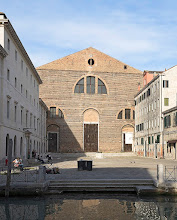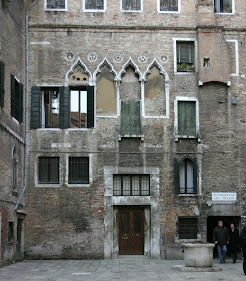Pina Menichelli – silent movie star
Screen diva who enjoyed worldwide fame
The actress Pina Menichelli, who became one of the most celebrated female stars of the silent movie era, was born on this day in 1890 in Castroreale, a village in northeast Sicily. Menichelli’s career was brief – she retired at the age of just 34 – but in her last eight or nine years on screen she enjoyed such popularity that her films played to packed houses and she commanded a salary that was the equivalent of millions of euros in today’s money. Without words, actors had to use facial expressions and body movements to create character in the parts they were playing and Menichelli, a naturally beautiful woman, exploited her elegance and sensuality to the full, at times pushing the limits of what was acceptable on screen. In fact, one of her films, La Moglie di Claudio (Claudio’s Wife) was banned by the censors for fear it would offend sensitivities, particularly those of the Catholic Church. Generally cast in the role of femme fatale, Menichelli thus became something of a sex symbol in the years after the First World War and there was considerable shock when she announced abruptly in 1924 that she was quitting the film industry for good. Read more…
_____________________________________
Giorgio Mondadori - publisher
Helped launch La Repubblica after family split
The publisher Giorgio Mondadori, who was president of the famous publishing house set up by his father, Arnoldo Mondadori, until an acrimonious split in 1976, died on his 92nd birthday on this day in 2009 in a clinic in Tuscany. Mondadori commissioned the Brazilian architect, Oscar Niemeyer, to build the company’s eye-catching headquarters in Segrate, near Milan, in 1975, which remains his legacy to the family business. At around the same time that he left the company, for whom he had worked for 38 years, he set up a joint venture with another publishing group, L’Espresso, that resulted in the launch of La Repubblica, a new, centre-left national newspaper that was to grow into one of the most popular daily newspapers in Italy, with a circulation topped only by the long-established Corriere della Sera. Born in Ostiglia, a small town in the province of Mantua, Lombardy, in 1917, Giorgio was the second of four children born to Arnoldo Mondadori and Andreina Monicelli, some 10 years after his father founded Arnoldo Mondadori Editore. After completing his education, Giorgio began working for the company in 1938 at the age of 21. Read more…
______________________________________
Flaminio Bertoni - sculptor and car designer
Visionary ideas turned Citroën into style icon
The sculptor and automobile designer Flaminio Bertoni, the creative genius behind the groundbreaking Citroën cars of the 1930s, 40s and 50s, was born on this day in 1903 in what is now the Masnago district of Varese. Bertoni, who lived in or near Paris from 1931 until his death in 1964, designed bodies for the stylish Traction Avant luxury executive car and the enduring workhorse 'Deux Chevaux' - the 2CV - which became almost a symbol of France. Yes both of these were eclipsed, some would say, by the brilliance of Bertoni's aerodynamic, futuristic Citroën DS - also known as 'the Goddess' - which was named the most beautiful car of all time by the magazine Classic and Sports Car and was described by the Chicago Institute of Design soon after its launch as among the '100 most beautiful things in the world'. Bertoni was fêted in France, where he was made a Knight of Arts and Letters by the government of Charles de Gaulle in 1961 but it was not until almost 40 years after his death that his achievements were given recognition in his home country, where his son, Leonardo, set up a museum in Varese to celebrate his work. Read more…
________________________________________
Aldo Ballarin - footballer
Brilliant defender who died in Superga tragedy
Aldo Ballarin, one of the 18 Torino players who were killed in the 1949 Superga plane crash, was born on this day in 1922 in the fishing port of Chioggia, at the southern tip of the Laguna di Venezia. Ballarin, whose brother, Dino, also died in the accident, played at right-back in the Torino team, making more than 150 appearances and winning the scudetto - the Serie A championship title - four seasons in a row between 1945 and 1949. A defender who was renowned for his tackling and heading ability but who also used the skills he had learned as a winger in his youth to be an effective attacker, Ballarin won nine international caps in the azzurri of Italy. He remains the only player born in Chioggia to play for the Italian national team. One of six children in his family, Aldo would play football for hours in the street near his home as he was growing up. Of his three brothers, two would also play professionally. Dino, who was a little under two years younger than Aldo, was on Torino’s books as a goalkeeper. At the age of 13, Aldo began playing for the youth team of Clodia, a local amateur club, before signing apprentice professional terms with Rovigo, a Serie C club about 55km (34 miles) from Chioggia. Read more…
______________________________________
Caesar crosses the Rubicon
Act of defiance that started a civil war and coined a phrase
The Roman general Julius Caesar led his army across the Rubicon river in northern Italy in an act of military defiance that would plunge the Roman Republic into civil war on this day in 49BC. The course of the Rubicon, which can still be found on maps of Italy today, entering the Adriatic between Ravenna and Rimini in northeast Italy, represented the border between the Roman province of Cisalpine Gaul, over which Caesar had command, and what was by then known as Italia, the area of the peninsula south of the Alps directly governed by Rome. One of the most powerful politicians in the Roman Republic after forming an alliance with Pompey and Crassus known as the First Triumvirate, Caesar had spent much of the previous decade expanding his territory through the Gallic Wars, taking control of much of modern-day France and northern Italy and extending the borders of the Republic as far as the Rhine. He was the first Roman general to invade Britain. The troops under his command - the 13th Legion - numbered more than 20,000 men who had seen Caesar’s military skills develop and were fiercely loyal. Read more…
______________________________________
John Dalberg-Acton – historian, politician and writer
Gladstone’s friend and adviser became an Italian Marquess
John Emerich Edward Dalberg-Acton, better known as Lord Acton, was born on this day in 1834 in Naples, which was then part of the Kingdom of the Two Sicilies. He was brought up as a Roman Catholic and was later denied entry to the University of Cambridge because of his religion. He is best remembered for the quote, ‘Power tends to corrupt, and absolute power corrupts absolutely’, which he once wrote in a letter to an Anglican bishop. Dalberg-Acton’s grandfather was Sir John Francis Edward Acton, who had been appointed by Queen Maria Carolina of Naples to reorganise the Neapolitan navy. His ability impressed her so much that she made him commander-in-chief of both the army and the navy of the Kingdom of Naples and he became Minister of Finance and eventually Prime Minister. His father was Sir Ferdinand Richard Acton, who had the Villa Pignatelli built on the Riviera di Chiaia in Naples. Dalberg-Acton was born in the villa to Sir Ferdinand’s wife, Maria Luisa Pellina de Dalberg, who was from Germany. The baby was baptised the next day in a small chapel in the villa. Dalberg-Acton was brought up to speak English, Italian, French and German. His father died when he was three years old. Read more…
______________________________________
Maurizio Sarri - football manager
Former coach of Juventus and Chelsea
The football coach Maurizio Sarri was born on this day in 1959 in Naples. Sarri, who has an unusual background for a professional football coach in that he spent more than 20 years in banking before devoting himself to the game full-time, took over as Chelsea manager in the summer of 2017, succeeding another Italian, Antonio Conte. Previously, he had spent three seasons as head coach at SSC Napoli, twice finishing second and once third in Serie A. He never played professionally, yet he has now held coaching positions at 20 different clubs. Sarri was born in the Bagnoli district of Naples, where his father, Amerigo, a former professional cyclist, worked in the sprawling but now derelict Italsider steel plant. It was not long, however, before the family moved away, however, first to Castro, a village on the shore of Lago d’Iseo, near Bergamo, and then to Figline Valdarno, in Tuscany, his father’s birthplace. It was there that Sarri grew up and played football for the local amateur team. A centre half, he had trials with Torino and Fiorentina but was deemed not quite good enough for the professional game. Read more…
______________________________________
San Pietro Orseolo – Doge of Venice and monk
Rich and powerful Doge made a life-changing decision
Pietro Orseolo, a former Venetian Doge who joined the Benedictine order, died on this day in 987. He was canonised by Pope Clement XII in 1731 and his feast day is celebrated on the anniversary of his death on 10 January each year. Pietro Orseolo became Doge of Venice in 976 but after just two years in office he left his palace in the middle of the night to go to France to become a monk. Orseolo was originally from a powerful family in Udine and at the age of 20 became commander of the Venetian fleet waging successful campaigns against pirate ships. He was elected Doge after the previous ruler of Venice had been killed in a revolt. Orseolo restored order to the city, built much needed hospitals and cared for widows and orphans. He started to rebuild the Doge’s palace and St Mark’s Basilica using his own money. But he suddenly left Venice to travel to southern France with three other Venetians to join a Benedictine abbey. It is believed he told no one about his decision in advance, not even his wife and family. After some years living as a monk performing menial tasks at the abbey, Orseolo went to live in the surrounding forest as a hermit. Read more…
_____________________________________
Book of the Day: A History of Italian Cinema, by Peter Bondanella and Federico Pacchioni
This second edition of A History of Italian Cinema is the much anticipated update from the author of the bestselling history, which has been published in four landmark editions and celebrated its 40th anniversary in 2023. Building upon decades of research, Peter Bondanella and Federico Pacchioni reorganised the original in order to keep the book fresh and responsive not only to the actual films being created in Italy in the 21st century but also to the rapidly changing priorities of Italian film studies and film scholars. The new edition brings the definitive history of the subject, from the birth of cinema to the present day, up to date with a revised filmography as well as more focused attention on the melodrama, the crime film, and the historical drama. The book is expanded to include a new generation of directors as well as to highlight themes such as gender issues, immigration, and media politics. Accessible, comprehensive, and heavily illustrated throughout, this is an essential purchase for any fan of Italian film.Peter Bondanella is the author of a number of groundbreaking books, including Hollywood Italians, The Cinema of Federico Fellini, and The Films of Roberto Rossellini. In 2009, he was elected to the European Academy of Sciences and the Arts for his contributions to the history of Italian cinema and his translations or editions of Italian literary classics (Dante, Boccaccio, Machiavelli, Vasari, Cellini). Federico Pacchioni is Sebastian Paul & Marybelle Musco chair of Italian studies at Chapman University, Orange, California, USA.

.jpg)
%20(1).jpg)








.jpg)

_-_VE_-_Umberto_I_di_Savoia_1%20(2).jpg)






.jpg)








.jpg)

.jpg)



.jpg)

.jpg)
